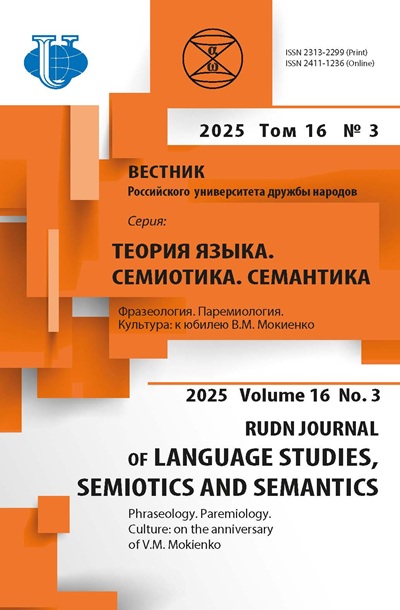ЯЗЫК И КУЛЬТУРА: КОНТЕКСТЫ НА АНГЛИЙСКОМ И ИРАКСКОМ АРАБСКОМ ЯЗЫКАХ
- Авторы: Мухаммед А.А.1
-
Учреждения:
- Открытый учебный колледж, Центр ад-Дивания, Ирак
- Выпуск: Том 9, № 3 (2018)
- Страницы: 761-773
- Раздел: НАУКА 21.0
- URL: https://journals.rudn.ru/semiotics-semantics/article/view/19438
- DOI: https://doi.org/10.22363/2313-2299-2018-9-3-761-773
- ID: 19438
Цитировать
Полный текст
Аннотация
Использование языка во взаимодействии влечет за собой нечто большее, чем просто обмен информацией о реалистичных идеях и объектах между людьми; это важный процесс, в котором отношения между людьми излагаются и обсуждаются. Любой язык относится к определенной культуре, поэтому изучение любого языка не означает изучение только грамматики и лексики этого языка, но на самом деле это изучение поведения и обычаев общества, а также характеристик, которые отличают это сообщество от других. Общение между людьми происходит через прямые языковые послания и другие послания, обозначаемые культурными особенностями, которые понимаются только через знание специфических для общества закономерностей, которые их породили. Идеальные и сложные отношения между языком и культурой показывают нам, что язык тесно связан с культурой, которые влияют друг на друга, развиваются вместе и в конечном итоге формируют то, что значит быть человеком. Поэтому, принимая участие в беседах, люди сознательно или бессознательно показывают свою идентичность, свое отношение к определенной культуре или группе, а также свое намерение сблизиться или отделить себя от других людей. Используя язык, люди определяют свои отношения друг с другом и идентифицируют себя как часть социальной группы, подразумевая, что язык - это культура, а культура - это язык.
Ключевые слова
Об авторах
Ахмед Альфуади Мухаммед
Открытый учебный колледж, Центр ад-Дивания, Ирак
Автор, ответственный за переписку.
Email: mohammedalfuadi@yahoo.co.uk
ассистент лектора, отдел английского языка, Открытый учебный колледж Эд-Дивании, Ирак; научные интересы: социолингвистика, теория дискурсивного анализа, социально-прагматика
Список литературы
- Rosenberg, S. (2004). “Face” Beyond Intractability. In: Conflict Information Consortium. University of Colorado, Boulder. URL: http://www.beyondintractability.org/essay/face (accessed: 14.06.2017).
- Cohen, R. (1987). Problems of intercultural communication in Egyptian-American diplomatic relations, International Journal of Intercultural Relations, II, 29-17.
- Barna, L. (1994). Stumbling Blocks in Intercultural Communication. In: Intercultural Communication. Publishing Company. pp. 337-346.
- Hofstede, G.J. (2005). Cultures and organizations: Software of the mind. New York: McGraw-Hill.
- Fox, K. (2004). Watching the English - The Hidden Rules of English Behaviour. London: Hodder & Stoughton.
- Kowol, A. & Szumieł, E. (2007). United Kingdom: communication, negotiations and cultural background. URL: http://works.adamkowol.info (accessed: 15.06.17).
- Faour, M. (1993). The Arab world after Desert Storm. Washington, DC: United States Institute of Peace Press.
- Feghali, E. (1997). Arab Culture Communication Patterns. International Journal of Intercultural Relations, 21(3), 345-378.
- Hofstede, G.J. (1984). Culture's consequences: International differences in work-related values. Beverly Hills, CA: Sage Publications.
- Almaney, A. J. & Alwan, A.J. (1982). Communicating with the Arabs: A handbook for the business executive. Prospect Heights, IL: Waveland Press.
- Adelman, M. & Lustig, M. (1981). Intercultural communication problems as perceived by Saudi Arabian and American managers. International Journal of Intercultural Relations, 5, 349-364.
- Gudykunst W.B. (Ed.). (1988). Theories in intercultural communication. Newbury Park: Sage.
- Ting-Toomey, S. (1988). Intercultural conflict styles: A face-negotiation theory. In Theories in intercultural communication. Newbury Park: Sage. pp. 213-235.
- Suleiman, M.W. (1973). The Arabs and the West: Communication gap. In Intercommunication among nations and peoples. New York: Harper & Row. pp. 287-303.
- Johnstone-Koch, B. (1983). Presentation as proof. The language of Arabic rhetoric. In: Anthropological Linguistics, 25(1), 47-55-60-151.
- Gilsenan, M. (1983). Recognizing Islam: Religion and society in the modern Arab world. New York, NY: Pantheon Books.
- Wolfson, N. (1981). Compliments in cross-cultural perspective. TESOL Quarterly, 15(12), 117-124.
- Maulawi A. (2004). The Holy Quran, Arabic Text and English Translation. Islam International Publication LTD.s
- Ting-Toomey, S. & Kurogi, A. (1998). Face work competence in intercultural conflict: An updated face-negotiation theory. International Journal of Intercultural Relations, 22, 187-225.
- Katriel, T. (1986). Talking straight: Dugri speech in Israeli Sabra culture. Cambridge: Cambridge University Press.
- Salem, T. (1967). Al Jisr: Iraqi Arabic play. Al Wazeriya, Baghdad: AL Masader press.
- Khalid, M. (1977). The sociocultural determinants of Arab diplomacy. In: Arab and American cultures Washington, DC: American Enterprise Institute for Public Policy Research. pp. 123-142.
- Nydell, M. (2006). Understanding Arabs: A Guide for Modern Times. Intercultural Press: Nicholas Brealey Publishing.
- Patai, R. (1983). The Arab mind (Revised Ed). New York: Charles Scribner’s Sons.
- The UK Government website (2007). The Arab World: An Introduction to Cultural Appreciation. URL: https://www.gov.uk/government/uploads/system/uploads/attachment_data/file/HYPERLINK (accessed: 15.01.2018).
- Dodd, P.C. (1973). Family honour and the forces of change in Arab society. International Journal of Middle East Studies, 4, 40-54.
- Mackey, S. (1987). Saudis: Inside the desert kingdom. New York: Signet.
- Sharabi, H. (1977). Impact of class and culture on social behaviour: The feudal bourgeois family in Arab society. In: Psychological Dimensions of Near Eastern studies Princeton, NJ: The Darwin Press. pp. 240-256.
- Yousef, F.S. (1974). Cross-cultural Communication: Aspects of Contrastive Social Values between North Americans and Middle Easterners. In: Human Organization: Winter 1974, Vol. 33(4). pp. 383-387.
- Eichelman, D.F. (1981). The Middle East: An anthropological approach. Englewood Cliffs, NJ: Prentice-Hall.
- Goffman, E. (1967). On face-work: an analysis of ritual elements in social interaction. In: Interaction Ritual: Essays on Face-to-Face Behaviour. New York: Pantheon Books. pp. 5-45.
Дополнительные файлы












